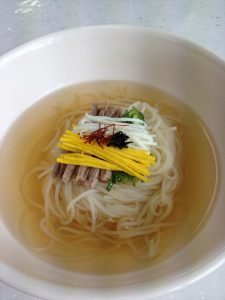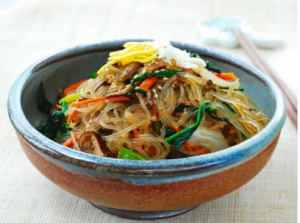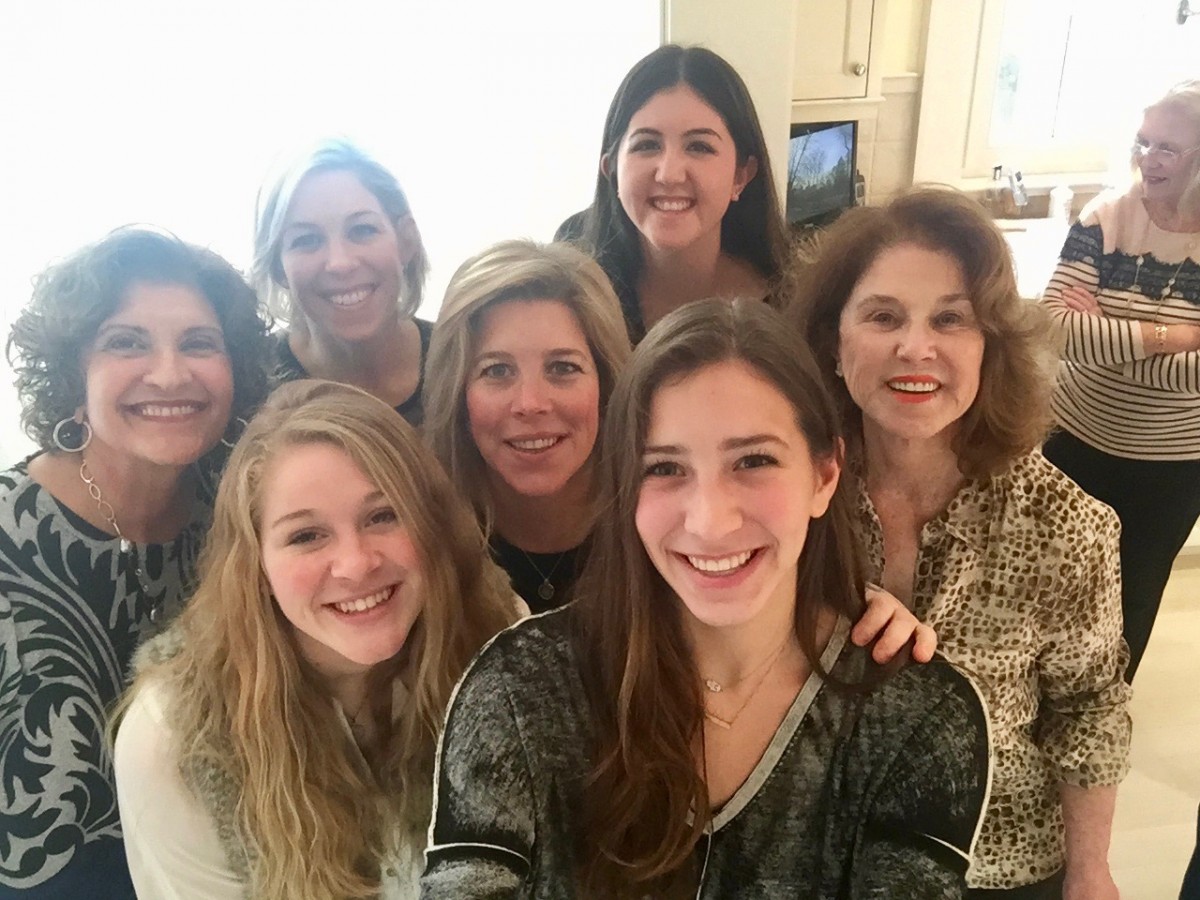Many families have unique recipes inherited from one generation to another for chicken noodle soup, carrot cakes, or exceptionally fluffy pancakes. My family boasts of a recipe even more unique: janchi gooksoo.
Janchi gooksoo literally translates to “party noodles” in Korean. Janchimeans “party” or “feast” typically centered around food, and when it’s time to celebrate a special occasion, you host a ma-eul janchi, or “a grand feast for everyone in the village”.Gooksoodirectly translates to “noodles.” Janchi gooksoo is made with a carefully stewed anchovy broth, most often served with finely chopped egg omelets, sautéed zucchinis, specially crafted sauce, pan-fried kimchi, and fine wheat noodles. My mother, raised in Seoul, inherited this recipe from my grandmother, raised in Daegu, who took a common recipe for janchi gooksoo and interpreted it her own way. Janchi gooksoo is usually eaten on special days like weddings and birthdays.
I took janchi gooksoo for granted until I left for college in 2016. Extremely homesick in a city I’ve never lived in before, I was craving homemade janchi gooksoo so I headed to a Korean restaurant in Duluth. As I took my first bite, something felt different, almost wrong. It was not the taste I was looking for, and I began to miss home even more. After the meal, I decided to make this dish myself.
Janchi gooksoo looks like a very simple dish; there’s not a lot of toppings and ingredients typically needed for this dish. I was pretty confident that I would nail this dish on my first try, for I have a huge heart for and experience with cooking. Knowing that other bowls of janchi gooksoo is nothing compared to my grandmother’s original recipe, I called her and jotted down a relatively simple set of directions along with a long list of ingredients. Many ingredients came to me as a surprise, but determined to satiate my homesick soul, I headed to one of the biggest chains of Korean markets in Georgia: H-Mart.
First, the broth. Nearly half of the ingredients on my list was for the broth alone. The most important ingredient for the broth was anchovies, but as I walked into the store, I saw thousands of different kinds of anchovies, all varying in color, size, and drying methods. My grandmother had told me to choose the big, fat anchovies silver in color, so I quickly threw a small bag of those anchovies in my cart. Then, I had to choose the right type of noodles. They had to be the thinnest kind made from flour. The biggest struggle was the soy sauce. The soy sauce had to be gook ganjangor “soup soy sauce” that was fermented and salted differently than regular soy sauce you would find in a sushi restaurant. The regular soy sauce would result in weak flavor, lacking the depth and richness of flavors that janchi gooksoo has. The dish wouldn’t be complete.
After a long stare down a long aisle of soy sauce and conversing with some of the workers there, I headed back home with what I thought was the right type of soy sauce. It was $4.99 before sales tax and dark brown just like what I was told by my grandmother.
When I finally arrived home with two hands full of groceries, I realized that I had never handled anchovies before. Brewing broth and taking care of anchovies was always a task that my mother or grandmother did for me even when I was cooking. In college, I had always gotten a pre-made pack of anchovies specifically made for making broth, so I never had to touch the tiny fish with my hands. The strong smell of the sea tickled my nose as I began to cut the anchovies’ backs to get rid of the intestines, and the crunchiness of the fish gave me goose bumps. I was already so frustrated and exhausted from cleaning out anchovies that I wanted to give up.
After bringing a pot of water to boil, I added a handful of clean anchovies, along with dried shitake mushrooms and dried shrimps. Two tablespoons of gook ganjangwas added as well. After 50 minutes of boiling the broth on low heat, a fishy smell filled up my house. It began to smell just like my grandmother’s house, and I was hungry for janchi gooksoo.
I turned the heat off to let the broth cool and began to work on the toppings that go on the dish. I cracked four eggs, carefully separating the whites and the yolk. I stirred the separated eggs to let it become softer, and on low heat, I began to fry a thin layer of egg whites and yolk. Once fully cooked like a freshly cooked crepe, I rolled it up and sliced them very thinly. I sautéed thinly sliced zucchini on the same pan with a hint of sesame oil. Lastly, again on the same pan, I grilled some kimchi, adding sesame seeds this time. When the broth reached room temperature, I put it in the fridge to make it cold, a secret twist to the recipe my family loves.
 (https://en.wikipedia.org/wiki/Janchi-guksu#/media/File:Janchi-guksu.jpg)
(https://en.wikipedia.org/wiki/Janchi-guksu#/media/File:Janchi-guksu.jpg)
A couple hours later, when the broth finally became cold, I boiled a pot of water again, this time to cook the noodles. The thin noodles cooked to my liking within minutes, and to keep the temperature of the dish consistent and cold, I washed the noodles under icy cold water. I get a handful of noodles and place them in a deep bowl. I included the pre-made toppings, all cold, on top of the noodles. To complete the dish, I poured the cold broth into the bowl. It is essential to add long strands of noodles without cutting them to wish the diners a long, happy life. They have to eat the entire bowl to ensure longevity enters their life.
“It smells like home,” I thought to myself. With a big smile on my face, I stared at my bowl for a couple minutes to let the rush of nostalgia run past me. I drank the broth. The cold soup chilled my bones as I decided that the janchi gooksoo is genuinely the best cold noodle soup.
The next morning, I called my grandmother and told her the story of my take on janchi gooksoo. I had done everything correctly, except the handling of anchovies. As soon as she saw a picture of my janchi gooksoo, she exclaimed, “Why are there bits of anchovies in your broth?” I supposed to take the head off of the anchovies along with the intestines, because often the eyes of the fish get in the broth, making it less aesthetically pleasant to look at. However, when I told her the name of the soy sauce that I used to make the broth, I could hear the proudness echoing in her voice.
Almost three years have gone by since the first time I made this dish. I’ve gained enough confidence to cook this dish for my friends in Atlanta. My grandmother taught me how to properly cook the broth nice and clean without anchovy bits. Sometimes I get lazy and don’t even remove the intestines, but the feast noodles still have an element of nostalgia and warmth.
The first meal I had when I came home for summer break a couple months ago was janchi gooksoo. It was a celebration of many events, including my last summer vacation as a college student. As I got ready to head home from a cold, but warm meal, my grandmother secretly slipped a piece of paper into my pocket. It had exact measurements of all the ingredients that I needed, including the brand names commonly found in Duluth’s H-Mart. She also slipped $20 into my pocket. With tears in my eyes, I just knew how exquisite my next bowl of janchi gooksoo were going to be.
The piece that I decided to imitate was “Ping A Mien, a Chinese Family Noodle Story.” I chose to use this piece of short story because of the way it was written. This story certainly felt special to me even though it was not drastically different from other pieces literature that we read for Tuesday’s class. It talked about noodles and family, a recurring theme in many of the stories that we read. However, the way it was written touched me in ways other stories did not. The author’s family also reminded me a lot of my own family. The way that the author’s mother instructed the author to make the noodles sounded very similar to my own mother. It felt casual, similar to my actual relationship with my mother and grandmother.
One of the biggest things that I learned from reading this piece is the language of love. Although I do not want to generalize this for everyone, I think families in Asia have a harder time expressing love through words. Love often times is shown through what is commonly thought of as criticism. When the author failed to choose the right type of noodles and incorrectly served the mushrooms in ping an mien, the author’s mother explicitly pointed out the authors mistakes. The author also states that she “could tell she was impressed.” This shows that the pride that Asian parents have for their children is not stated as “Oh wow, you are awesome,” but rather as “You could have done this better, but I’m still (subtly) proud of you.” The author and her mother also fought before the author left to go to the airport, and her mother brought out a warm bowl of symbolic noodles. This is a very stereotypical scene in Asian households; when parents get in an argument with their children, they try to resolve the issue by preparing them their favorite dish. Such encounter of the author’s family made me reflect on my own cultures. I soon realized that I shouldn’t be disappointed by the lack of verbal expression of love in my family but should be thankful for the small acts of kindness that my family does for me. Just like the author, I am still loved by my family.
This silent love language is embedded throughout the ping an mien piece and my piece equally. Not once did the author’s parents say “I love you” in the piece. In my short story, my grandmother and mother both do not say this phrase either. This culture of unspoken love is rather expressed through actions. The fact that the author tried to make the noodles on her own strictly following her mother’s recipe shows the love she has for her mother. The way that the mom gave the author a warm bowl of soup also depicts love. The way that my grandmother snuck a piece of an exact recipe in my pocket shows how much she loves me. She did not say, “I love you,” but the way she researched how much each ingredient costs in Atlanta shows the devoted love she has for me. Both the author and I connected with our roots through a bowl of noodles, and she and I connected over unspoken love.

 (
(
